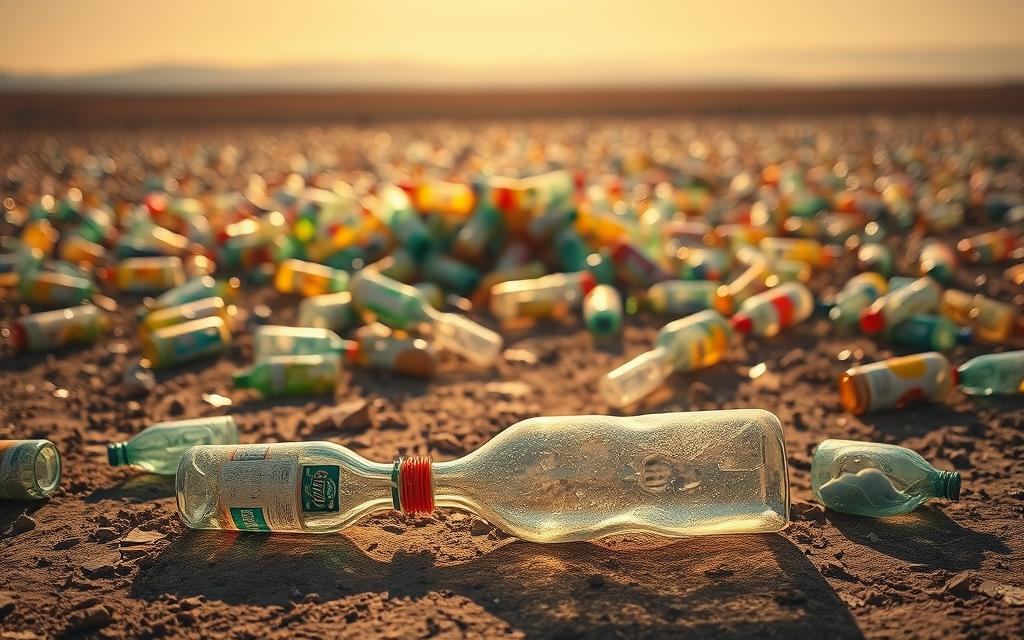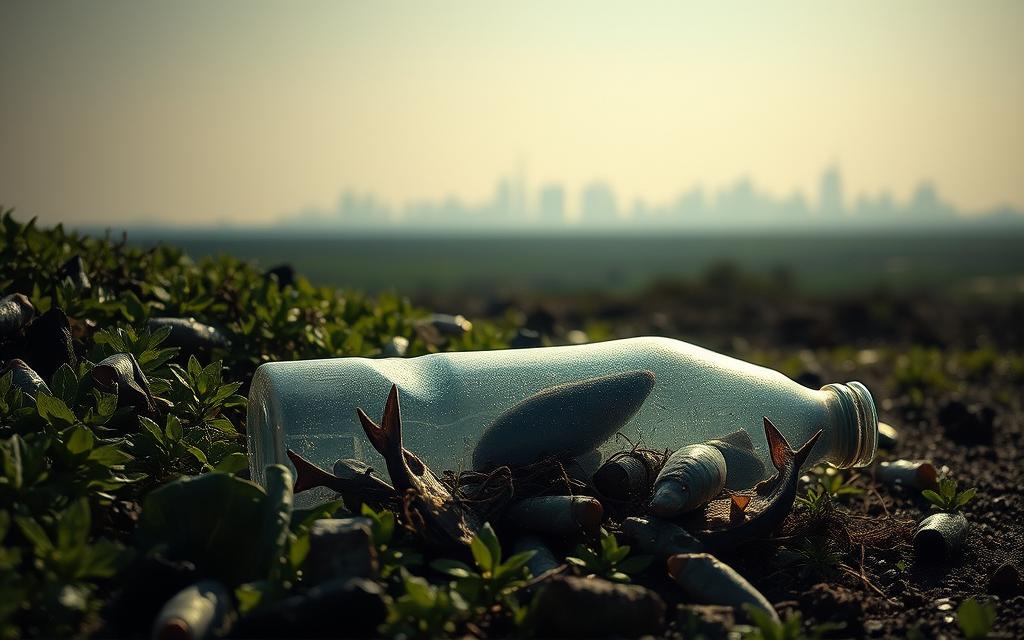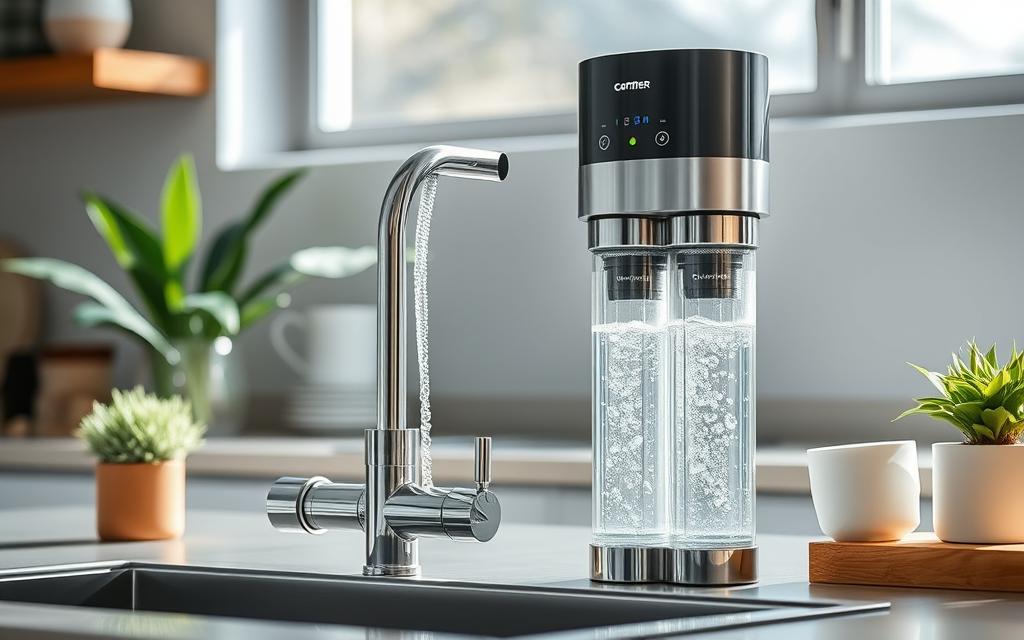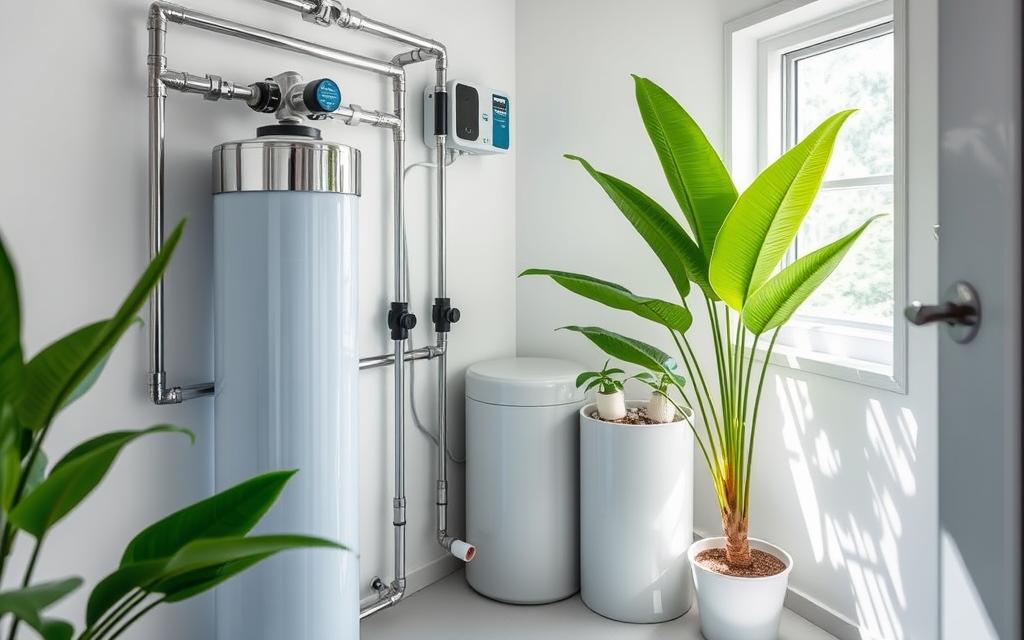Ever thought about what happens to plastic water bottles after you throw them away? Did you know that every plastic bottle you’ve ever used is likely to be on our planet forever?
Plastic water bottles take a very long time to break down. They can stay in our environment for over 1,000 years. This creates a huge problem for our planet. It’s important to understand how long they take to decompose to see the full damage they cause.
I’m exploring the world of plastic bottle breakdown to reveal a shocking truth. These everyday items are causing huge harm to our planet, from landfills to oceans.
Key Takeaways
- Plastic bottles take over 1,000 years to decompose
- Every plastic bottle ever created is likely to be on our planet forever
- Plastic waste harms many parts of our environment
- Small actions can help reduce plastic pollution
- Knowing the problem is the first step to making a difference
Introduction to Plastic Bottles
Plastic bottles are a big part of our lives, but they harm the environment a lot. As someone who cares about the planet, I’ve seen how they change how we use things and affect our world.

The harm from plastic water bottles goes way beyond just using them. The damage plastic bottles do to our planet is a big problem that we need to fix fast.
Understanding Plastic Bottles and Their Use
Plastic bottles are everywhere, used in many ways. Let’s look at how they’re used:
- Beverage containers
- Personal care product packaging
- Cleaning solution bottles
- Food storage containers
“Every single piece of plastic ever created is here today.” – Environmental Research Foundation
The Scope of Plastic Waste in the Environment
The amount of plastic made is huge. Here are some numbers to show how big the problem is:
| Plastic Production Metric | Annual Volume |
|---|---|
| Total Global Plastic Production | 300 million tons |
| Single-Use Plastic Percentage | 50% |
| Plastic Bottles Produced Annually | 480 billion |
| Recycling Rate | 9% |
These numbers show a harsh truth about our plastic use. The ease of plastic bottles has a big environmental price. Every bottle we throw away hurts our planet for a long time. It’s key for us to know and tackle this big issue.
The Decomposition Timeline of Plastic Bottles
Plastic bottles are a big problem because they take so long to break down. Learning about how long it takes for plastic to decompose shows us how bad our plastic use is.
From the moment we use a plastic bottle, it starts a long journey. It shows how long plastic stays in our world.
How Long Do They Take to Decompose?
Plastic bottles can take 450 to 1,000 years to fully decompose. This means that every plastic bottle I’ve used could be around for a very long time.
- Plastic water bottles: approximately 450 years
- Plastic soda bottles: up to 700 years
- Thick plastic containers: potentially 1,000 years
Factors Affecting Decomposition Rates
Several important things affect how fast plastic breaks down:
- Environmental temperature
- Exposure to sunlight
- Type of plastic material
- Chemical additives in the plastic
Instead of really breaking down, plastic turns into tiny pieces called microplastics. These tiny pieces stay in our environment for a long time, causing big problems.
One plastic bottle can break into thousands of microplastic particles that stay in the environment for generations.
The Composition of Plastic Bottles
Plastic bottles are made of complex chemicals that affect how they break down. Knowing what’s in them helps us understand their impact on the environment.
Plastic bottles come from petroleum, leading to big environmental problems. Their breakdown depends on their chemical makeup.
Materials That Define Plastic Bottles
Most plastic bottles are made from certain synthetic polymers:
- Polyethylene Terephthalate (PET) – Most common material
- High-Density Polyethylene (HDPE) – Durable and resistant
- Polypropylene (PP) – Versatile and heat-resistant
Chemical Additives and Decomposition
Manufacturers add various chemicals that affect how plastic bottles break down. These additives can speed up or slow down the breakdown process.
Some common additives include:
- UV stabilizers – Prevent sunlight-induced degradation
- Plasticizers – Enhance flexibility
- Colorants – Provide visual characteristics
The mix of these chemicals means plastic bottles can last for centuries. This creates big challenges for the environment.
Environmental Impact of Plastic Bottles
Plastic bottles are a big problem for our planet. They harm wildlife, soil, and water. The damage goes beyond just throwing them away.
- Landfills are full of plastic that won’t break down
- Plastic is killing marine life
- Animals get trapped or eat plastic thinking it’s food
- Plastic can leak harmful chemicals into the soil and water
Impact on Landfills and Wildlife
Millions of plastic bottles go to landfills every year. They can take 450 years to break down. This leaves a huge mark on our environment. Animals get sick or die because they think plastic is food.
Effects on Soil and Water Sources
Plastic bottles also harm our soil and water. Tiny pieces of plastic get into our drinking water and food. These tiny pieces carry harmful chemicals that can hurt our health and the environment.
“Our planet’s health depends on addressing plastic pollution at its source.” – Environmental Research Institute
We need to understand these problems to find ways to fix them. We must protect our planet for the future.
The Microplastics Dilemma
Plastic pollution is a big problem, with microplastics being a major issue. These tiny plastic pieces harm our environment and health. We need to act fast to solve this problem.
When plastic bottles break down, they turn into smaller pieces. These small pieces are called microplastics. They are less than 5 millimeters and are everywhere in our environment.
Understanding Microplastics
Microplastics come from many sources. But, it’s scary to know that plastic bottles take hundreds of years to fully break down. They keep getting smaller and smaller during this time.
- Primary microplastics: Made at tiny sizes
- Secondary microplastics: Come from bigger plastic breaking down
- Size range: Less than 5 millimeters
“About half of all plastic pollution is underwater, a lot of it microplastics. They’re so small, we might never clean them up fully.”
Plastic Bottles’ Microplastic Contribution
Every plastic bottle can become a source of microplastic pollution. They break down into tiny pieces when exposed to sunlight, water, and stress. These pieces get into our water, soil, and food.
Knowing how microplastics work helps us see why we need to change. We need better ways to manage waste and use sustainable alternatives. Together, we can reduce this big environmental problem.
Recycling Plastic Bottles
Recycling plastic bottles is key to reducing waste and saving resources. In the U.S., it’s a big part of managing waste sustainably. Knowing how to recycle plastic water bottles helps our planet a lot.
Here are the main steps for eco-friendly disposal of plastic water bottles:
- Clean bottles well before recycling
- Take off bottle caps and labels
- Look up local recycling rules
- Sort plastics by their recycling code
Why Recycling Matters
Recycling plastic bottles cuts down landfill waste and saves resources. I found out that recycling one plastic bottle can power a computer for 25 minutes.
| Plastic Type | Recycling Rate | Common Reuse |
|---|---|---|
| PET (Type 1) | 29.1% | New bottles, clothing fibers |
| HDPE (Type 2) | 31.2% | Plastic lumber, pipes |
| Other Types | 12.5% | Various industrial products |
Correct Recycling Techniques
To recycle right, follow these tips:
- Rinse bottles well
- Crush bottles to save space
- Keep recyclables clean from food
- Use the right recycling bins
Pro tip: Always check your local recycling center’s specific guidelines, as requirements can vary between different municipalities.
Alternatives to Plastic Bottles
More people are looking for ways to reduce plastic waste. This includes finding sustainable alternatives to plastic water bottles. I’ll show you some innovative and eco-friendly options that can help.
Choosing the right reusable bottle can greatly reduce your carbon footprint. Here are some top alternatives that make a real difference:
- Stainless Steel Bottles: Durable, long-lasting, and 100% recyclable
- Glass Bottles: Chemical-free and easy to clean
- Copper Bottles: Natural antimicrobial properties
- Biodegradable Plant-Based Bottles: Made from sustainable materials
Benefits of Reusable Bottles
Switching to reusable bottles has many benefits. They are good for your health and the environment. Each reusable bottle can replace hundreds of single-use plastic bottles, greatly reducing waste.
| Bottle Type | Environmental Impact | Lifespan |
|---|---|---|
| Stainless Steel | Minimal waste | 5-10 years |
| Glass | Fully recyclable | 3-5 years |
| Biodegradable | Lowest environmental footprint | 1-2 years |
Practical Tips for Sustainable Hydration
To get the most out of your reusable bottle, follow these tips:
- Clean your bottle regularly
- Invest in a high-quality bottle
- Carry it everywhere to avoid single-use plastics
- Choose bottles made from sustainable materials
By making small changes in our daily habits, we can have a big impact. We can reduce plastic waste and protect our environment.
Public Awareness and Education
Plastic pollution is a big problem that needs our attention now. Knowing how long it takes for plastic to break down is key to solving it.
We need to teach people about plastic waste in many ways. National Geographic Explorer Heather J. Koldewey showed us how important community efforts are.
Empowering Community Action
Good education can change how we handle plastic waste. Here are some ways to do it:
- Make educational programs fun for schools
- Host recycling workshops in local areas
- Plan community clean-up events
- Use social media to spread the word
Grassroots Initiatives Making a Difference
Local groups are key in fighting plastic pollution. They focus on real solutions and get people involved. This helps a lot in reducing waste and making our environment better.
“Every individual action contributes to a larger environmental movement.”
Knowing how long plastic takes to decompose motivates us to choose better. It can take 450 to 1,000 years for plastic bottles to break down. Every small action we take is important for our planet.
Personal Engagement Strategies
- Go to local environmental workshops
- Support efforts to reduce plastic use
- Teach others about plastic waste
- Join community recycling programs
By learning and working together, we can change how we deal with plastic waste. This can lead to real environmental improvements.
Government Regulations and Policies
Fixing plastic bottle pollution needs strong government steps. The world is changing fast, with countries making new rules to fight plastic bottle harm.
Places all over are finding new ways to cut down plastic waste. They’re working on rules for making, using, and throwing away plastics.
Current Regulatory Landscape
Many places have made big changes to fight plastic waste. A 2018 UN report showed sixty countries have rules against single-use plastics and polystyrene.
- Bans on single-use plastic bottles in specific regions
- Mandatory recycling programs
- Extended producer responsibility laws
- Deposit-return schemes for plastic containers
Future Sustainable Policies
The future of plastic rules is looking good. New policies aim to make a world where waste is less and recycling is more.
| Policy Type | Impact Level | Implementation Status |
|---|---|---|
| Extended Producer Responsibility | High | Growing Globally |
| Plastic Bottle Taxes | Medium | Increasing |
| Mandatory Recycling Quotas | High | Emerging |
Working together is key to solving plastic bottle pollution. By setting global standards, we can lessen plastic bottle harm worldwide.
Conclusion: What I Can Do to Help
Exploring plastic bottle decomposition has shown me how much we can change the environment. Knowing how long plastic takes to break down motivates us to use less plastic. This knowledge should push us to make better choices about plastic use.
I’ve decided to start with simple but effective steps. I’ll use a reusable water bottle to cut down on plastic waste. When I do use plastic, I’ll recycle it properly. These actions can stop many plastic bottles from harming our environment.
Next, I aim to spread the word about living sustainably. I’ll teach my loved ones about eco-friendly habits and the harm plastic causes. I’ll also encourage our community to join in. Together, we can make a big difference in reducing plastic waste and saving our planet.
Even small actions can add up to big changes. I’m ready to do my part, starting with one reusable bottle at a time. Together, we can make a real difference.



